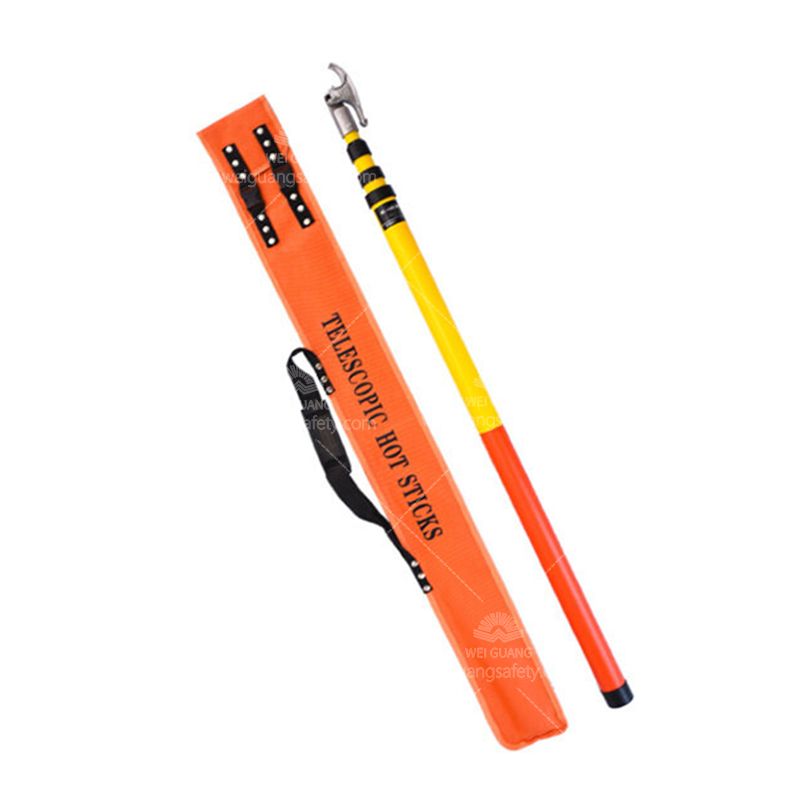Telescopic Hot Stick vs. Traditional Hot Stick: Which Is Safer and More Efficient for Electrical Work?
Understanding the Evolution of Hot Sticks
In the world of electrical maintenance and high-voltage line work, safety and efficiency are non-negotiable. Hot sticks—insulated tools used to handle live equipment—have long been a standard for linemen and utility workers. However, with the advent of telescopic hot sticks, users now have a flexible, space-saving alternative to traditional one-piece models. This article compares telescopic and traditional hot sticks across several critical dimensions to help procurement teams and safety managers make the right choice.
Application: Versatility vs. Simplicity
Traditional hot sticks are typically manufactured in fixed lengths, ranging from 4 to 12 feet or more. While they offer high rigidity, users often need to carry multiple sticks for varying applications—such as disconnecting switches or installing fuse cutouts. Telescopic hot sticks, on the other hand, can be extended in increments, usually up to 40 feet, depending on the model. This flexibility makes them more versatile, especially in scenarios where different reach lengths are required for the same task.
For example, a utility worker performing inspections on overhead lines may need to adjust reach based on terrain or pole height—an advantage made possible with a telescopic design.
User Group: Field Technicians vs. Maintenance Crews
Traditional hot sticks are favored by crews working in predictable, stable environments such as substations or maintenance yards, where tools are readily stored and space is not a concern. Their consistent length and solid structure are familiar to seasoned linemen.
Telescopic hot sticks, by contrast, are especially popular among mobile teams and emergency responders. Their compact collapsed form—often as short as 5 feet—makes transportation and on-site storage much easier. For companies with field technicians covering wide service areas, telescopic versions reduce the need for bulky tool carriers or extra vehicle space.

Performance and Safety: Stability vs. Adaptability
Performance-wise, both stick types meet OSHA and ASTM F711 standards for dielectric integrity. Traditional sticks generally provide slightly more rigidity due to their one-piece construction, which can result in steadier handling for tasks requiring precise control, like manipulating a cutout or a hook stick.
Telescopic sticks, while slightly more flexible, are engineered with locking mechanisms to maintain structural stability when fully extended. Some models feature silicone-treated fiberglass sections to enhance grip and resist moisture. For high-voltage work up to 500 kV, both types are safe when properly inspected and maintained. However, the adjustable reach of fiberglass telescopic sticks offers adaptability in hard-to-access areas where ladder use is limited or unsafe.
Price Consideration: Budget vs. Long-Term Value
Traditional hot sticks are generally less expensive up-front, with prices ranging from $150 to $400 depending on length and application. However, organizations often need to purchase multiple lengths to cover various jobs, which can lead to higher cumulative costs.
Telescopic hot sticks come at a higher initial price—typically $350 to $800—but their all-in-one design reduces the need for additional tools. In terms of total cost of ownership, businesses that value compactness and multi-functionality may find the telescopic option more economical over time.
Usage Scenarios: Fixed-Site vs. Dynamic Environments
In controlled environments such as substations, where space is abundant and tools are routinely stored and maintained, traditional hot sticks perform well. Their durability and simple design suit repetitive tasks with minimal equipment variation.
Conversely, telescopic hot sticks shine in dynamic field environments. For example, linemen conducting storm damage assessments may need a collapsible tool that fits inside a service vehicle or can be carried over uneven terrain. In these cases, the telescopic model minimizes physical strain and logistical hassle.
Advantages and Disadvantages
Traditional Hot Sticks
Advantages: Rigid structure for precision, lower initial cost, no moving parts.
Disadvantages: Bulky for transport, requires multiple lengths, less flexible in the field.
Telescopic Hot Sticks
Advantages: Adjustable reach, compact storage, ideal for mobile crews.
Disadvantages: Higher initial investment, more components to inspect and maintain.
Conclusion: Match the Tool to Your Work Environment
When choosing between a telescopic and a traditional hot stick, the decision largely depends on your operational environment and usage patterns. For stationary crews in well-equipped facilities, the reliability and cost-effectiveness of traditional hot sticks remain attractive. However, for organizations prioritizing mobility, efficiency, and adaptability, telescopic hot sticks provide a modern solution to evolving worksite demands.
Ultimately, both tools have their place in the safety toolkit. Consider your team's workflow, storage capabilities, and the range of tasks at hand to determine which type of hot stick delivers the safest and most efficient performance for your electrical work.



